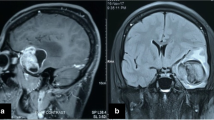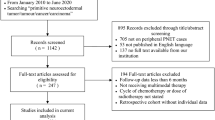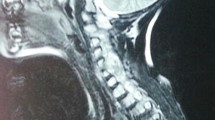Abstract
Supratentorial primitive neuroectodermal tumors (S-PNET) that develop in children have recently been classified into two types: central-type PNET (C-PNET), which has been reported over the years, and peripheral-type PNET (P-PNET), which develops intracranially and was referred to as Ewing's sarcoma in the past. P-PNET is fundamentally a malignant tumor, but the patient reported here represents a case of long-term survival from onset without recurrence. At the age of 21 months, a male infant developed a cranial bone deformity and symptoms of high intracranial pressure. A CT scan revealed a cystic tumor attaching to the falx, and cyst drainage operation was immediately performed. The intracranial tumor was then resected. The tumor was an intradural extramedullary tumor, and it was totally excised with the falx attachment. The tumor was initially diagnosed as a neuroblastoma, and postoperative treatment consisted of administration of radiotherapy and chemotherapy using cyclophosphamide and vincristine. Twenty years have now passed without any recurrence. Recent repeated performance of histopathological analysis resulted in a diagnosis of P-PNET. In recent years, studies in molecular biology have demonstrated that P-PNET involves the EWS-FLI1 chimeric gene, and immunohistochemical staining has shown P-PNET to be MIC2 positive. P-PNET also differs from C-PNET with regard to prognosis, and for this reason it is believed that P-PNET and C-PNET should be considered separate entities. That is, in spite of the fact that P-PNET is a malignant tumor, patient survival can be comparatively long. Because P-PNET originates intracranially, it is fundamentally an intradural extramedullary tumor. For this reason, treatment should consist of surgical excision that is as complete as possible, followed by appropriate radiotherapy and chemotherapy. This approach can be expected to result in the patient's long-term survival.
Similar content being viewed by others
References
MN Hart KM Earle (1973) ArticleTitlePrimitive neuroectodermal tumors of the brain in children Cancer (Phila) 32 890–897 Occurrence Handle10.1002/1097-0142(197310)32:4<890::AID-CNCR2820320421>3.0.CO;2-O Occurrence Handle1:STN:280:DyaE2c%2FivVKguw%3D%3D
LB Rorke MN Hart RE McLendon (2000) Supratentorial primitive neuroectodermal tumour (PNET) P Kleihues WK Cavenee (Eds) World Health Organization classification of tumors: pathology and genetics of tumors of the nervous system IARC Lyon 141–144
AT Reddy AJ Janss PC Phillips et al. (2000) ArticleTitleOutcome for children with supratentorial primitive neuroectodermal tumors treated with surgery, radiation, and chemotherapy Cancer (Phila) 88 2189–2193 Occurrence Handle10.1002/(SICI)1097-0142(20000501)88:9<2189::AID-CNCR27>3.0.CO;2-G Occurrence Handle1:STN:280:DC%2BD3c3ntlGjtg%3D%3D
Y Katayama S Kimura T Watanabe et al. (1999) ArticleTitlePeripheral-type primitive neuroectodermal tumor arising in the tentorium; case report J Neurosurg 90 141–144 Occurrence Handle10413168 Occurrence Handle1:STN:280:DyaK1MzjvFGisQ%3D%3D
M Papotti G Abbona A Pagani et al. (1998) ArticleTitlePrimitive neuroectodermal tumor of the meninges: an histological, immunohistochemical, ultrastructural, and cytogenetic study Endocr Pathol 9 275–280 Occurrence Handle12114719 Occurrence Handle10.1007/BF02739968
A Utsunomiya H Uenohara S Suzuki et al. (2004) ArticleTitleA case of peripheral-type primitive neuroectodermal tumor arising in the dura mater at the frontal base (in Japanese) No To Shinkei (Brain and Nerve) 56 237–241
NL Antunes A Lellouch-Tubiana C Kalifa et al. (2001) ArticleTitleIntracranial wing sarcoma/‘peripheral’ primitive neuroectodermal tumor of dural origin with molecular genetic confirmation J Neuro-Oncol 5 51–56 Occurrence Handle10.1023/A:1006432919281
F Dedeurwaerdere C Giannini R Sciot et al. (2002) ArticleTitlePrimary peripheral PNET/Ewing's sarcoma of the dura: a clinicopathologic entity distinct from central PNET Mod Pathol 15 673–678 Occurrence Handle12065782 Occurrence Handle10.1038/modpathol.3880585
K Bunyaratavej S Khaoroptham C Phonprasert et al. (2005) ArticleTitlePrimary intracranial peripheral primitive neuroectodermal tumor/Ewing's sarcoma presenting with acute intracerebral hemorrhage Clin Neuropathol 24 184–190 Occurrence Handle16033135 Occurrence Handle1:STN:280:DC%2BD2MznsFCqtw%3D%3D
LB Rorke (1983) ArticleTitleThe cerebellar medulloblastoma and its relationship to primitive neuroectodermal tumors J Neuropathol Exp Neurol 42 1–15 Occurrence Handle6296325 Occurrence Handle1:STN:280:DyaL3s7htFSlsw%3D%3D Occurrence Handle10.1097/00005072-198301000-00001
The Committee of Brain Tumor Registry of Japan; The Japanese Pathological Society (1995) Histological classification of tumours of the central nervous system. In: General rules for clinical and pathological studies on brain tumors, 1st edn. Kanahara, Tokyo, pp 4–8
BH Cohen PM Zeltzer JM Boyett et al. (1995) ArticleTitlePrognostic factors and treatment results for supratentorial primitive neuroectodermal tumors in children using radiation and chemotherapy: a childrens' cancer group randomized trial J Clin Oncol 13 1687–1696 Occurrence Handle7602359 Occurrence Handle1:STN:280:DyaK2MzisFyrtQ%3D%3D
HJ Yang DH Nam KC Wang et al. (1999) ArticleTitleSupratentorial primitive neuroectodermal tumor in children: clinical features, treatment outcome and prognostic factors Childs Nerv Syst 15 377–383 Occurrence Handle10447606 Occurrence Handle10.1007/s003810050418 Occurrence Handle1:STN:280:DyaK1Mzns1Orsw%3D%3D
SU Stechschulte JJ Kepes FP Holladay et al. (1994) ArticleTitlePrimary meningeal extraosseous Ewing's sarcoma: case report Neurosurgery 35 143–147 Occurrence Handle7936137 Occurrence Handle10.1097/00006123-199407000-00023 Occurrence Handle1:STN:280:DyaK2M%2Fit1Sqsg%3D%3D
K Yoshizato S Yoshioka T Tamai et al. (1999) ArticleTitleIntracranial primitive neuroectodermal tumor in an infant: a case report (in Japanese) No Shinkei Geka (Neurological Surgery) 27 243–248 Occurrence Handle1:STN:280:DyaK1M3gs1WmtQ%3D%3D
J Niwa N Shimoyama Y Takahashi (2001) ArticleTitlePrimitive neuroectodermal tumor involving the frontal skull base in an infant Childs Nerv Syst 17 570–574 Occurrence Handle11585334 Occurrence Handle10.1007/s003810100469 Occurrence Handle1:STN:280:DC%2BD3MrjvVeksw%3D%3D
F Dedeurwaerdere C Giannini R Sciot et al. (2002) ArticleTitlePrimary peripheral PNET/Ewing's sarcoma of the dura: a clinicopathologic entity distinct from central PNET Mod Pathol 15 673–678 Occurrence Handle12065782 Occurrence Handle10.1038/modpathol.3880585
N Horinaka Y Ito M Miyajima et al. (2005) ArticleTitleIntracranial peripheral primitive neuroectodermal tumor manifesting as abducens nerve palsy Childs Nerv Syst 21 327–330 Occurrence Handle15657787 Occurrence Handle10.1007/s00381-004-1053-9 Occurrence Handle1:STN:280:DC%2BD2M7msFahtg%3D%3D
M Idrees C Gandhi S Betchen et al. (2005) ArticleTitleIntracranial peripheral primitive neuroectodermal tumors of the cavernous sinus: a diagnostic peculiarity Arch Pathol Lab Med 129 e11–e15 Occurrence Handle15628919
BC Mobley D Roulston GV Shah et al. (2006) ArticleTitlePeripheral primitive neuroectodermal tumor/Ewing's sarcoma of the craniospinal vault: case reports and review Hum Pathol 37 845–853 Occurrence Handle16784984 Occurrence Handle10.1016/j.humpath.2006.02.011
V Jay M Pienkowska L Becker et al. (1995) ArticleTitlePrimitive neuroectodermal tumors of the cerebrum and cerebellum: absence of t(11;22) translocation by RT-PCR analysis Mod Pathol 8 488–491 Occurrence Handle7675766 Occurrence Handle1:STN:280:DyaK2Mvgs1WqsA%3D%3D
PB Dirks L Harris HJ Hoffman et al. (1996) ArticleTitleSupratentorial primitive neuroectodermal tumors in children J Neuro-Oncol 29 75–84 Occurrence Handle10.1007/BF00165520 Occurrence Handle1:STN:280:DyaK28vhsVeqsg%3D%3D
BH Kushner PA Meyers WL Gerald et al. (1995) ArticleTitleVery-high-dose short-term chemotherapy for poor-risk peripheral primitive neuroectodermal tumors, including Ewing's sarcoma, in children and young adults J Clin Oncol 13 2796–2804 Occurrence Handle7595741 Occurrence Handle1:CAS:528:DyaK28XitlGltw%3D%3D
GM Dosik V Rodriguez RS Benjamin et al. (1978) ArticleTitleNeuroblastoma in the adult: effective combination chemotherapy Cancer (Phila) 41 56–63 Occurrence Handle10.1002/1097-0142(197801)41:1<56::AID-CNCR2820410110>3.0.CO;2-2 Occurrence Handle1:STN:280:DyaE1c7gsFWgsw%3D%3D
Author information
Authors and Affiliations
Corresponding author
Rights and permissions
About this article
Cite this article
Asano, K., Kikuchi, J., Munakata, A. et al. An infant case of intracranial peripheral-type primitive neuroectodermal tumor with long-term survival. Brain Tumor Pathol 24, 69–74 (2007). https://doi.org/10.1007/s10014-007-0218-0
Received:
Accepted:
Published:
Issue Date:
DOI: https://doi.org/10.1007/s10014-007-0218-0




